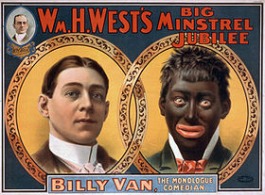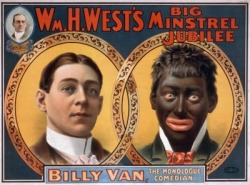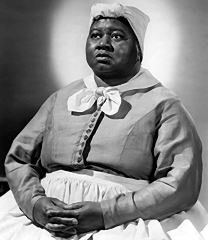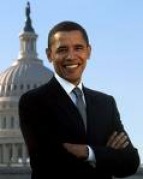Representation of Black Hollywood:
Research:
Blackface:

poster showing the transformation from white to 'black
Blackface, in the narrow sense, is a style of theatrical makeup that originated in the United States, used to take on the appearance of certain archetypes of American racism. Blackface was an important performance tradition in the American theater for roughly 100 years beginning around 1830. It quickly became popular overseas, particularly so in Britain, where the tradition lasted even longer than in the US. White blackface performers in the past used burnt cork and later greasepaint or shoe polish to blacken their skin and exaggerate their lips, often wearing woolly wigs, gloves, tailcoats, or ragged clothes to complete the transformation. Later,black artists also performed in blackface.
By the mid-20th century, changing attitudes about race and racism effectively ended the prominence of blackface makeup used in performance in the U.S. and elsewhere. It remains in relatively limited use as a theatrical device, mostly outside the U.S., and is more commonly used today as social commentary or satire. Through the 1930s, many well-known entertainers of stage and screen also performed in blackface. Whites who performed in blackface in film included Al Jolson, Eddie Cantor, Bing Crosby and Judy Garland. In the early years of film, black characters were routinely played by whites in blackface. In the first known film of Uncle Tom's Cabin (1903) all of the major black roles were whites in blackface. Even the 1914 Uncle Tom starring African American actor Sam Lucas in the title role had a white male in blackface as Topsy. D. W. Griffith's The Birth of a Nation (1915) used whites in blackface to represent all of its major black characters, but reaction against the film's racism largely put an end to this practice in dramatic film roles. Thereafter, whites in blackface would appear almost exclusively in broad comedies or "ventriloquizing" blackness in the context of a vaudeville or minstrel performance within a film.
By the mid-20th century, changing attitudes about race and racism effectively ended the prominence of blackface makeup used in performance in the U.S. and elsewhere. It remains in relatively limited use as a theatrical device, mostly outside the U.S., and is more commonly used today as social commentary or satire. Through the 1930s, many well-known entertainers of stage and screen also performed in blackface. Whites who performed in blackface in film included Al Jolson, Eddie Cantor, Bing Crosby and Judy Garland. In the early years of film, black characters were routinely played by whites in blackface. In the first known film of Uncle Tom's Cabin (1903) all of the major black roles were whites in blackface. Even the 1914 Uncle Tom starring African American actor Sam Lucas in the title role had a white male in blackface as Topsy. D. W. Griffith's The Birth of a Nation (1915) used whites in blackface to represent all of its major black characters, but reaction against the film's racism largely put an end to this practice in dramatic film roles. Thereafter, whites in blackface would appear almost exclusively in broad comedies or "ventriloquizing" blackness in the context of a vaudeville or minstrel performance within a film.
Black Minstrel Shows & Bert Williams:
Williams was a key figure in the development of African-American music. In an age when racial inequality and stereotyping were an accepted part of life, he became the first black American to take a lead role on the Broadway stage, and did much to push back racial barriers during his career. Fellow vaudevillian W.C. Fields, who appeared in productions with Williams, described him as "the funniest man I ever saw – and the saddest man I ever knew."
By 1840, African-American performers also were performing in blackface makeup. When all-black minstrel shows began to proliferate in the 1860s, they often were billed as "authentic" and "the real thing". These "colored minstrels “always claimed to be recently-freed slaves (doubtlessly many were, but most were not) and were widely seen as authentic. This presumption of authenticity could be a bit of a trap, with white audiences seeing them more like "animals in a zoo" than skilled performers. Despite often smaller budgets and smaller venues, their public appeal sometimes rivaled that of white minstrel troupes.
By 1840, African-American performers also were performing in blackface makeup. When all-black minstrel shows began to proliferate in the 1860s, they often were billed as "authentic" and "the real thing". These "colored minstrels “always claimed to be recently-freed slaves (doubtlessly many were, but most were not) and were widely seen as authentic. This presumption of authenticity could be a bit of a trap, with white audiences seeing them more like "animals in a zoo" than skilled performers. Despite often smaller budgets and smaller venues, their public appeal sometimes rivaled that of white minstrel troupes.
Blackface - Bamboozled:
Essay:
“Media representations rarely challenge the dominate values of society nor do they give a voice to those with little power”. To what extent do you think this statement is true for the group or place you have studied?

Karl Marx
I believe that this is a very important area to discuss as it is very true in terms of how the media is run today. The dominate class (white, middle class, middle aged, heterosexual men) are in control of the media today as they’re the ones that write the television shows, report the news, direct the cameras and ect. Therefore their ideas are the ones that are seen and they make sure that the “other voices” don’t get heard. The people with little power are mainly the other minority groups such as Black people and disabled people. The group that I am going to be discussing today is Black Hollywood.
Marxist theory of the media is that it is linked to the economic base of society (capitalism). The dominate class; the owners of the media companies decide what the audiences watch and how each group of people are represented. In addition to that, Marxist argues that in order to maintain social order, the media made sure that even the minority groups of society were represented. However, this representation is just done so that the minority groups feel as if they are being presented but in fact in fact they are being represented according to how the dominate class wants them to be seen.
Marxist theory of the media is that it is linked to the economic base of society (capitalism). The dominate class; the owners of the media companies decide what the audiences watch and how each group of people are represented. In addition to that, Marxist argues that in order to maintain social order, the media made sure that even the minority groups of society were represented. However, this representation is just done so that the minority groups feel as if they are being presented but in fact in fact they are being represented according to how the dominate class wants them to be seen.
There are many stereotypes of black people seen in the media today. Some of those are “The Tom – the Good Negro”, “The Coon – crazy, lazy and the most degraded of all black stereotypes”, “The Tragic Mulatoo – fair-skinned and trying pathetically to pass for a white”, “The mammy – loud, independent and overweight female” and “The Brutal black Buck – big, bad niggers, violent and over-sexed”. Black people are usually represented in a negative way in the media and are always seen as people that are in lower classes and also into guns, sex, drugs, violent and aggressive behaviour. We see these representations in British movies and Hollywood movies; they are also seen in many music videos that are made by black stars. Movies such as kidult hood and crash sow the negative representation of black people; they are seen dealing with things such as drugs, violent and sex. These representations have been made up by the dominate class and the audiences have taking them in and have believed them even though they are not 100% accurate. Black people don’t always fit into those categories as some of them are hard working people who struggle to get anywhere due to the representation of them seen in the media. Movies such as bullet boy, pursuit of happiness and coach carter show a different side of the black people, in these movies we see the black people trying to change their lives for the best and don’t want to be seen in a negative way. However, they are always seen struggling getting to where they wish to go.

Black Face
The first time black characters were seen on screen were white characters in “Blackface” Blackface, in the narrow sense, is a style of theatrical makeup that originated in the United States, used to take on the appearance of certain archetypes of American racism. Blackface was an important performance tradition in the American theater for roughly 100 years beginning around 1830. White blackface performers in the past used burnt cork and later greasepaint or shoe polish to blacken their skin and exaggerate their lips, often wearing woolly wigs, gloves, tailcoats, or ragged clothes to complete the transformation. Later on even black poeple performed in blackface and starting to take part in these movies even though they were degrading to them. Between the years 1910 and 1915 there was a series of movies showing black people as either foolish, grinning children clowning about to make white people laugh or as bestial savages. Egbert Austin "Bert" Williams and Hattie McDaniel were some of the most famous black actors of their time. Hattie McDaniel was the first black person to win an Oscar for her role in the movie gone with the wind.The representations of the black people at that time were stereotypical and degrading. By the mid-20th century, changing attitudes about race and racism effectively ended the prominence of blackface makeup used in performance in the U.S. and elsewhere. This shows that even in the early years of the movies Black people were seen as the minority group and that their representation was very negative. In today’s media very little has changed, their still represented in a negative way however from a different area. Before they were seen as fools now they are seen as criminals.

Hattie McDaniel
Many would question why black actors took part in these movies if they were represented in them in such a negative way. The answer to that question is money. Many black people at that time were working as servants and were not often seen in professional jobs as they did not get them due to their colour. The movies at that time paid a lot therefore many of them were willing to go along with the negative representations in order to get money. Hattie McDaniel said “The only choice permitted us is either to be servants for seven dollars a week or portray them for seven hundred dollars a week”. At the time the black actors were paid much less then the white actors even if they had done the same amount of work and that was seen as degrading them as well. However, today black actors are getting paid the same as white actors and sometimes even more. Black actors such as Will Smith are scoring $20 million dollars a movie! In addition to that, black characters are more seen as entertainers; singers and actors then people with professional jobs such as lawyers or doctors. An example of this is the movie “ in the heat of the night” the main character is a black police man who gets captured by a white police man who accuses him for stealing just based on the fact that he is black. When he confesses that he is a police man himself the white characters are seen to be in shock. This just shows that to see black people in professional jobs is shocking as there mainly seen as entertainers and this is mainly portrayed by their representations that the dominate class makes.

Barack Obama
History was made when Obama become president and that was mainly because he was black. He was the first black president in the USA. Many black people felt that all the hard work and the struggle that they have been through have finally been paid off when the most powerful country in the world picked a black person as their president. Like many black people Obama struggled a lot to get to where he has got. One of the well known presenters’s read a paragraph from Obama’s book where Obama talks about his background and his struggles. This was done in order to show the audiences that the minority groups always struggle due to their backgrounds in order to get to the top.
In conclusion, I think this statement is very true in terms of my studied group. Black Hollywood/people are seen as a minority group and a group with little voice and that the Dominate group decides how the minority group are represented and shown to the audiences. In addition to that because the minority groups have little power and they are incapable of changing these representations and this links to the Marxist theory that the people in power that have the money have control over everybody else.
In conclusion, I think this statement is very true in terms of my studied group. Black Hollywood/people are seen as a minority group and a group with little voice and that the Dominate group decides how the minority group are represented and shown to the audiences. In addition to that because the minority groups have little power and they are incapable of changing these representations and this links to the Marxist theory that the people in power that have the money have control over everybody else.
